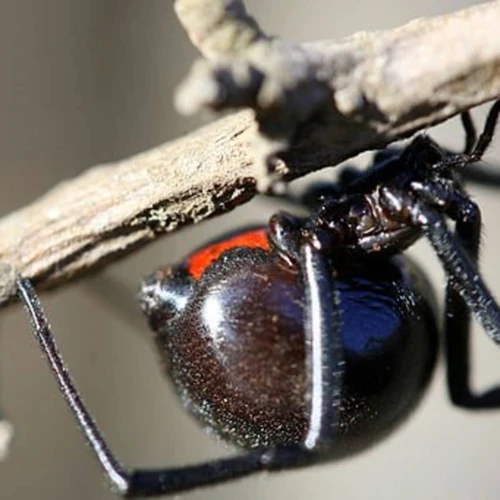Introduction
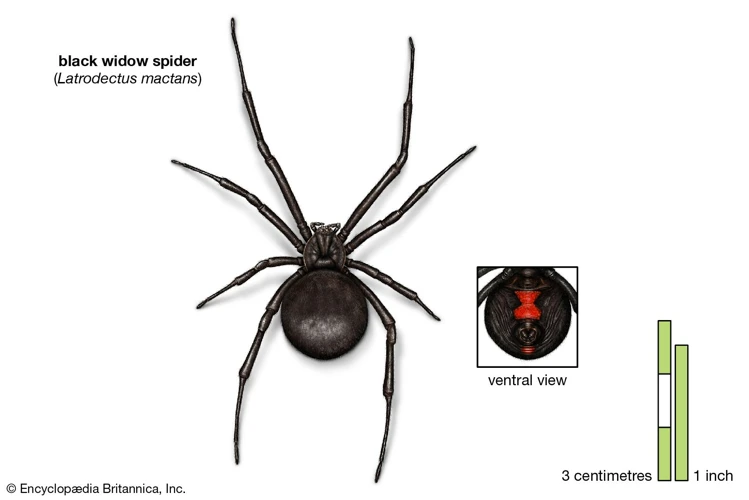
Landscaping can be a fulfilling hobby for many homeowners, as it allows them to beautify their property and create a relaxing outdoor environment. However, it’s important to be aware of the potential dangers that can come along with landscaping materials, such as the presence of black widow spiders. These venomous spiders are known for their painful bites, which can be dangerous for those with a weakened immune system. In this article, we will explore the topic of black widow spiders in landscaping materials and offer tips on how to prevent their presence on your property.
About Black Widow Spiders
Black widow spiders are one of the most well-known and venomous spiders. They are a common sight in the United States and can be found in every state except Alaska. Knowing how to identify them is crucial for preventing potential bites. Here is some information about the black widow spider that you need to know:
| Appearance: | The adult female black widow spider is easily identifiable by its shiny black body and red hourglass-shaped marking on the underside of its abdomen. Males and juvenile black widow spiders have unique patterns on their abdomens and are smaller than females. |
| Web: | The webs created by black widow spiders are irregular and strong. They are typically located in dark, quiet areas such as garages, cluttered areas, and woodpiles. |
| Habitat: | Black widow spiders prefer warm, dry environments and can often be found in outdoor clutter or debris. They are also frequently found in landscaping materials such as mulch, soil, and rocks. |
| Bite: | A black widow spider bite can be painful and can cause symptoms such as cramping, muscle spasms, and nausea. While most bites are not fatal, medical attention should be sought immediately. |
| Breeding: | Black widow spiders reproduce in the spring and summer months. Females can lay several egg sacs containing hundreds of eggs each. |
It is important to take precautions when dealing with black widow spiders to prevent bites and potential health risks. Knowing how to identify them and where they are commonly found is the first step in prevention. If you suspect that you have black widow spiders in your yard or home, searching the area carefully and taking proper measures to remove and prevent their presence is crucial.
Identifying Black Widow Spiders
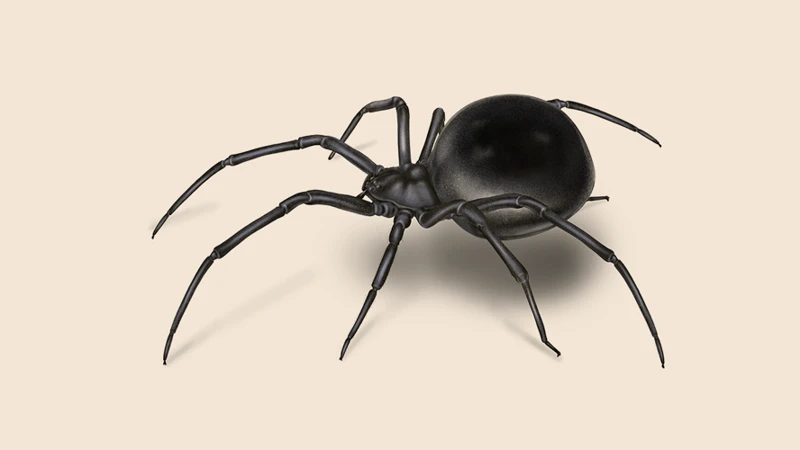
Black Widow Spiders are not easy to identify at first glance, and many people mistake them for other spider species. However, there are some key characteristics to look for to identify them properly. Female Black Widow Spiders are shiny and black, with a discernible red hourglass shape on their undersides. This hourglass can also be an orange or yellow color in some cases. Juvenile Black Widow Spiders have the same patterns, but their colors might not be as distinct. Male Black Widow Spiders are smaller than the females and have a lighter coloration.
Another way to identify Black Widow Spiders is by looking at their webs. They create irregular, tangled webs that have no distinct pattern, but they do contain some silk threads that are stronger than others. These threads are traplines and help the spider detect prey that has landed in its web. Black Widow spiderlings are cannibalistic, which means they eat each other, so if you find a mass of spiderlings, it might be that only one or two are left.
It’s essential to be able to identify Black Widow Spiders because they are venomous and can cause health problems when they bite. If you suspect there is a Black Widow Spider in your landscaping materials, be sure to take precautions and contact a professional. Remember, prevention is key, so taking steps to avoid attracting Black Widow Spiders is the best course of action.
Why Landscaping Materials Attract Black Widow Spiders
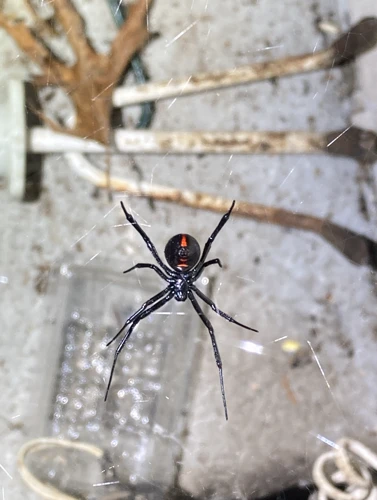
Landscaping materials can attract black widow spiders for a number of reasons. One of the main reasons is that these materials can provide the spiders with shelter and a place to build their webs. Black widows prefer to construct their webs in protected, dark areas such as in between rocks, in wood piles, or in plant debris. Yard debris like leaves, branches, and grass clippings can also provide hiding places for black widows.
Another factor that can attract black widows to landscaping materials is moisture. Spiders require a certain level of moisture to survive, and some landscaping materials can provide the ideal environment. For example, mulch and soil used in potted plants can retain moisture and provide a humid environment that black widows find attractive.
Certain types of landscaping materials can also attract the insects and other small prey that black widows feed on. For example, firewood can attract beetles and other insects that spiders prey on. This makes it a prime location for black widows to spin their webs and catch their prey.
It’s important to note that black widows are more commonly found in warm, dry climates. However, this doesn’t mean that they won’t be found in other areas. Any place where there is an abundance of outdoor clutter, such as debris, woodpiles, and outdoor furniture, can be a potential hiding spot for black widows. It’s essential to be cautious when moving or touching outdoor items that have been sitting for long periods of time.
In the next section, we will discuss some prevention tips to help keep black widows away from your home and landscaping materials.
Black Widow Spider Prevention Tips
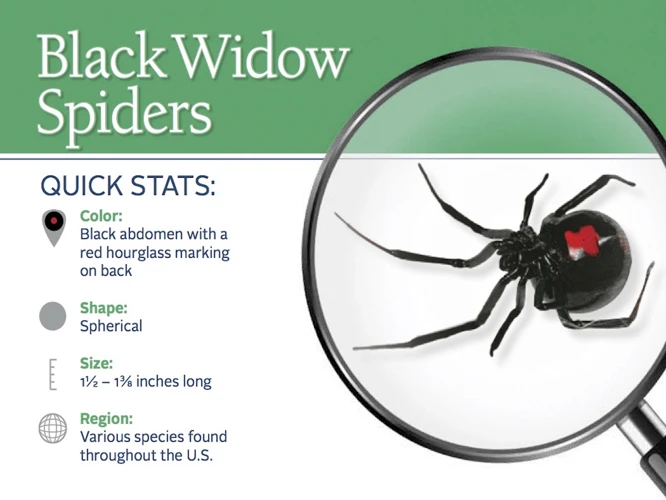
When it comes to landscaping materials, black widow spiders can pose a significant threat. These spiders can be difficult to spot, and their bites can be extremely dangerous. Prevention is key. Here are some helpful tips that can help you keep your yard and garden free of black widow spiders. By following these tips, you can reduce your risk of encountering these dangerous spiders in your outdoor spaces. Make sure to also check out our previous article on outdoor clutter that can attract black widows.
Inspect Materials Before Bringing Them Home
Inspecting landscaping materials before bringing them home is an essential step in preventing black widow spider infestations. You never know where these spiders may be hiding, and so, you should take care to check everything thoroughly. Here are some tips on what to look for when inspecting landscaping materials:
| Landscaping Materials | What to Look For |
|---|---|
| Mulch | Check for black widow spider nests or egg sacs. Also, make sure the mulch is dry and not moldy, which can attract other pests. |
| Potted Plants and Soil | Inspect the entire plant and soil for black widow spiders or their egg sacs. Look for any signs of damage or wilting, which could indicate the presence of spider mites or other pests. |
| Firewood | Check for black widow spiders, egg sacs, or webs. Make sure the wood is dry and stored off the ground to prevent moisture and other pest infestations. |
| Rock Piles and Debris | Move any rocks or debris around to check for black widow spider nests or hiding spots. Inspect the area thoroughly before bringing any materials home. |
Remember to wear gloves and protective clothing while inspecting landscaping materials, and if you are unsure whether something is safe to bring home, err on the side of caution and leave it behind. If you do find black widow spiders or their nests, it is best to call a pest control professional to handle the situation safely.
It’s important to note that not all landscaping materials are likely to attract black widow spiders. However, certain materials are more susceptible to spider infestations than others. In the next section, we’ll take a look at some common landscaping materials that are known to attract black widow spiders and how to prevent infestations.
Click here to learn about how to locate black widow spider nests in your yard debris.
Store Materials Properly
Proper storage of landscaping materials is also important in preventing black widow spiders from making a home in your yard or garden. When not in use, all outdoor materials should be stored in a dry, well-ventilated area such as a shed or garage. It is important to seal any gaps or cracks where spiders and other pests could enter. Additionally, using plastic storage containers with tight-fitting lids can help keep pests out.
It is recommended to keep these materials off the ground and away from the house as much as possible. This not only helps to prevent spider infestations, but also makes it easier to inspect the materials for pests before using them in landscaping. Storing materials properly also helps to prevent moisture buildup, which is attractive to black widow spiders and other pests.
Below is a table of common landscaping materials and recommended storage methods to prevent black widow spiders.
| Landscaping Materials | Recommended Storage |
|---|---|
| Mulch | Store in a dry area or under a covered structure, off the ground. |
| Potted Plants and Soil | Store in a dry area or under a covered structure, off the ground. Use plastic pots with tight-fitting lids. |
| Firewood | Store in a dry area off the ground, away from the house. |
| Rock Piles and Debris | Store in a dry area off the ground, away from the house. |
Regularly inspecting and cleaning stored materials can also help to prevent black widow spiders from nesting. It is important to wear gloves and other protective clothing when handling these materials, and to be cautious when reaching into dark or enclosed spaces where spiders may be hiding. By following these precautions and storing materials properly, you can minimize the risk of black widow spiders and other pests making their home in your landscaping materials.
If you want to learn more about how to keep black widow spiders out of your yard and home, you can check out our article about black widow threats in yard debris or read our guide on keeping black widows out of your garage.
Wear Protective Clothing
It is important to wear protective clothing when handling landscaping materials to prevent black widow spider bites. Black widow spiders are often found in dark, damp places, and can easily hide in bags of mulch or firewood. Wearing long-sleeved shirts, pants, gloves, and closed-toe shoes can provide a barrier between your skin and any potential black widow spiders.
Additionally, it is recommended to wear thick clothing or thick gloves when handling potentially infested areas to prevent accidental bites. Black widow spiders are known for their black body and red hourglass shape on their underside, so it is important to be aware of their appearance. Remember that juvenile black widow spiders may not have the hourglass shape and can have different coloration.
When working in areas known to be inhabited by black widow spiders, consider using bug spray to add an extra layer of protection. Be sure to follow the instructions on the bug spray’s label. Remember that wearing protective clothing when handling outdoor materials extends beyond just black widow spiders. Other potentially dangerous pests, such as snakes or wasps, can inhabit landscaping materials.
Wearing protective clothing can greatly reduce the risk of being bitten by a black widow spider when handling landscaping materials. Wear closed-toe shoes, long-sleeved shirts and pants, and thick gloves to prevent accidental bites. Spray bug repellent on the clothes and skin to add another layer of protection to prevent harmful insect and spider bites. By being aware of these risks and taking the proper precautions, you can safely handle outdoor materials without worrying about black widow spiders.
What to Do If You Find a Black Widow Spider
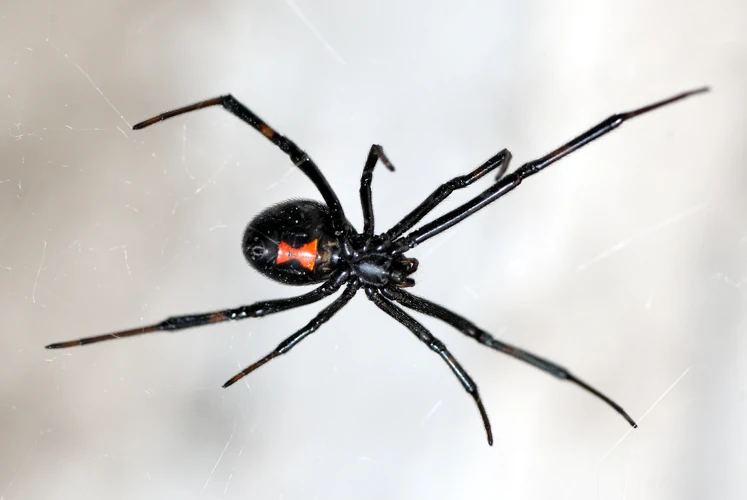
Encountering a black widow spider can be scary, but it’s important to stay calm and take the necessary steps to protect yourself and others. Black widow spiders are not aggressive and will only bite if they feel threatened or are provoked. If you find a black widow spider in your landscaping materials, removal is the best course of action. Here are the steps to follow if you find a black widow spider:
- Put on protective clothing before attempting to remove the spider. Wear long sleeves, pants, gloves, and closed-toe shoes to reduce the risk of being bitten.
- Use a tool such as a stick or tongs to carefully capture the spider. Do not attempt to pick up or handle the spider with your hands.
- Move the spider to a different location away from your home and other people. Do not try to kill the spider.
- Inspect the area where the spider was found to make sure there are no other black widow spiders or spider nests present. If there are, follow the same steps to carefully remove them.
- Seek medical attention if you or someone else is bitten by a black widow spider. Symptoms of a bite include muscle pain, stiffness, cramps, and spasms.
If you are not comfortable with removing the spider yourself, consider hiring a professional pest control service to handle the situation. Prevention is key when it comes to preventing black widow spiders in your landscaping materials, but knowing how to safely remove them can provide peace of mind in case of an unexpected encounter.
If you want to learn more about how to spot black widow spider webs or how to identify juvenile black widow spider habits, check out our articles on how to spot black widow spider webs and juvenile black widow spider habits respectively.
Common Landscaping Materials That Attract Black Widow Spiders
As much as we love landscaping, it’s important to know that certain materials can attract black widow spiders. These arachnids are notorious for their venomous bite and can cause serious harm to humans. To help you stay safe, we’ve compiled a list of common landscaping materials that you should be aware of. Make sure to read on so you know what materials to be on the lookout for when working in your yard.
Mulch
Mulch is a popular material used in landscaping for various purposes like conserving soil moisture, controlling weed growth, and improving soil quality. However, it is also a favorite hiding place for black widow spiders, making it essential to take precautions when handling it.
When using mulch, it’s best to wear protective clothing, including gloves and long-sleeved shirts and pants. Inspect the mulch carefully before using it to ensure that there are no signs of spider activity. Signs of spider activity may include spider webs or egg sacs, which are small white to tan balls where a lot of spider babies live inside.
It’s important to note that not all mulch is created equal when it comes to attracting black widow spiders. Organic mulch, such as bark chips or leaves, tends to attract spiders more than inorganic mulch such as rock. Using inorganic mulch is a great way to minimize the possibility of spiders being attracted to your landscaping materials, as well as reducing the amount of moisture in which they thrive.
If you spot a black widow spider, do not attempt to handle it, instead reach out to professionals like /outdoor-black-widows/ to remove the spider. As black widow spiders tend to have a preference for moist and humid environments, it may be useful to remove the mulch and allow the area to dry out before replacing it with inorganic materials
| Pros | Cons |
| Organic mulch helps to improve soil quality over time | Organic mulch is attractive to black widow spiders |
| Organic mulch is more aesthetically pleasing than inorganic mulch | Organic mulch retains moisture, which may attract spiders |
| Provides a good, natural base for garden beds | May contain other pests such as termites or fire ants |
If you opt to use organic mulch, it is recommended that you take measures to prevent spider activity. Be sure to spread the mulch out so that it is not too thick, and avoid piling it against the foundation of your home. Regularly inspecting it and being cautious while handling it can also help to minimize the risk of spider bites.
While mulch can be an effective landscaping material, if you’re dealing with black widow spiders, you need to be cautious. Always take steps to prevent spider activity and inspect your materials carefully before bringing them home. Consider using inorganic mulch or removing the organic mulch altogether to reduce the risk of spider activity in your landscaping.
Potted Plants and Soil
Potted plants and soil can be a prime location for black widow spiders to build their nests. These spiders prefer dark, undisturbed areas and can easily hide among the leaves and soil of potted plants. When purchasing new potted plants, it’s essential to inspect them thoroughly before bringing them into your home or garden.
Here are some tips to prevent black widow spiders from making their home in your potted plants:
- Inspect the soil: Before buying a new potted plant, check the soil for any signs of pests or spider webs. If you notice any issues, avoid purchasing the plant.
- Keep plants elevated: Elevate your potted plants off the ground using plant stands or shelving. This can make it less appealing for black widow spiders to create their nests.
- Check regularly: Regularly check the leaves and soil of your potted plants for any signs of black widow spiders. If you notice any, carefully remove the spider and the nest and relocate the plant to a more open area.
- Use natural repellents: Certain plants, such as eucalyptus or lavender, can help repel black widow spiders. Consider planting them near your potted plants or using essential oils to deter spiders from making their home in your plants.
If you do find a black widow spider nest in your potted plants, it’s essential to take precautionary measures. Do not attempt to remove the nest yourself as black widow spiders are venomous and can be dangerous. Instead, contact a pest control professional who can safely remove the nest.
To learn more about other landscaping materials that attract black widow spiders, refer to the relevant sections in this article, such as “/black-widow-spider-nests/” and “/black-widow-spiders-outdoor-furniture/”(if relevant). By being diligent and taking necessary precautions, you can ensure that your potted plants and soil are not a target for black widow spiders.
Firewood
Firewood can be another spot where black widow spiders may be hiding, especially if it’s being stored outside. When stacking firewood, it’s important to keep an eye out for spider webs, egg sacs, and spiders themselves. Here are some tips to avoid encountering black widows while handling firewood:
- Wear gloves: Protect your hands by wearing gloves when you handle firewood, as this is a dark, cozy place for black widow spiders to hide.
- Use a flashlight: Check for spiders and webs by shining a flashlight into the crevices between the logs. Black Widows spiders are known to hide in the small spaces.
- Store firewood properly: Consider storing firewood off the ground to help prevent spiders and other pests access to it.
Remember, it is crucial to shake out or inspect each piece of firewood before bringing it inside. Black widow spiders can be small and well-camouflaged in woodpiles, so it’s essential to be vigilant to avoid getting bitten.
Rock Piles and Debris
Rock piles and debris are other favorite hiding spots for black widow spiders, particularly if they are undisturbed for long periods. These piles of rocks or debris can provide an ideal habitat for black widows to build their webs and thrive, so it is important to keep these areas clean to avoid attracting them in the first place.
Tips for Managing Rock Piles and Debris:
- Regularly clean up any debris or refuse that accumulates in your yard or garden to make sure spiders do not make themselves at home in this clutter.
- Keep rock piles to a minimum, and only use them in areas where they are necessary, rather than for decorative purposes.
- If you do need to have a rock pile in your yard, always wear a sturdy pair of gloves when working around it, and be cautious when moving or removing rocks.
- When working with or near rock piles or debris, carefully inspect the area first, preferably with a stick or broom to avoid getting too close, and watch out for any signs of spider webs or egg sacs.
- If you do encounter a black widow spider in your rock pile or debris, call a pest control professional to remove it safely.
Keeping your yard clean and well-maintained is crucial for keeping black widow spiders at bay, especially when it comes to rock piles and other debris. With vigilance and a little effort, you can create a safe and spider-free environment for yourself and your family.
Conclusion
In conclusion, it is crucial to understand the risks associated with black widow spiders in landscaping materials. While these spiders can be dangerous, there are ways to prevent their presence in your yard. By inspecting materials before bringing them home, storing them properly, wearing protective clothing, and being cautious when working in areas where black widow spiders are known to hide, you can significantly reduce the likelihood of encountering these spiders.
It’s also important to be aware of common landscaping materials that attract black widow spiders, such as mulch, potted plants and soil, firewood, and rock piles and debris. By taking extra care when handling these materials, you can avoid unintentionally bringing black widow spiders into your yard.
Remember, if you do find a black widow spider in your yard or home, it is best to call a professional to remove it safely. Trying to remove the spider yourself can be dangerous and may lead to a painful bite.
Overall, while it may be tempting to overlook the potential risks associated with landscaping materials, it is essential to take the necessary precautions to ensure your safety and the safety of those around you. With a bit of care and attention, you can enjoy a beautiful and safe outdoor space free from the threat of black widow spiders.
Frequently Asked Questions
What is the venomousness of a black widow spider?
Black widow spiders are the most venomous spider in North America, but their bites are rarely fatal.
How can you identify a black widow spider?
Black widow spiders are identified by their shiny black body with a distinctive hourglass shape on the underside of the abdomen.
Are black widow spiders attracted to all types of landscaping materials?
No, black widow spiders are typically attracted to moist and dark areas, so landscaping materials that retain moisture and provide shelter are most attractive.
Do all black widow spider bites require medical attention?
No, not all black widow spider bites require medical attention, but it is important to monitor the bite and seek medical help if severe symptoms develop.
What is the best way to inspect materials for black widow spiders?
The best way to inspect materials is to carefully examine them, paying attention to dark and moist areas where the spiders may hide.
Can black widow spiders live indoors?
Yes, black widow spiders can live indoors in basements, crawl spaces, and other dark and moist areas.
What are the most effective ways to prevent black widow spiders?
The most effective ways to prevent black widow spiders are to inspect and store materials properly, wear protective clothing, and keep landscaping areas clean and dry.
Can insecticides be used to prevent black widow spiders?
Yes, insecticides can be effective at preventing black widow spiders if used correctly and in combination with other prevention methods.
What should you do if bitten by a black widow spider?
You should clean the bite area with soap and water, apply a cool compress, and seek medical attention if severe symptoms develop.
Can black widow spiders be safely relocated?
No, it is not recommended to relocate black widow spiders due to the potential risks of spreading the spiders or causing harm to the spider.

